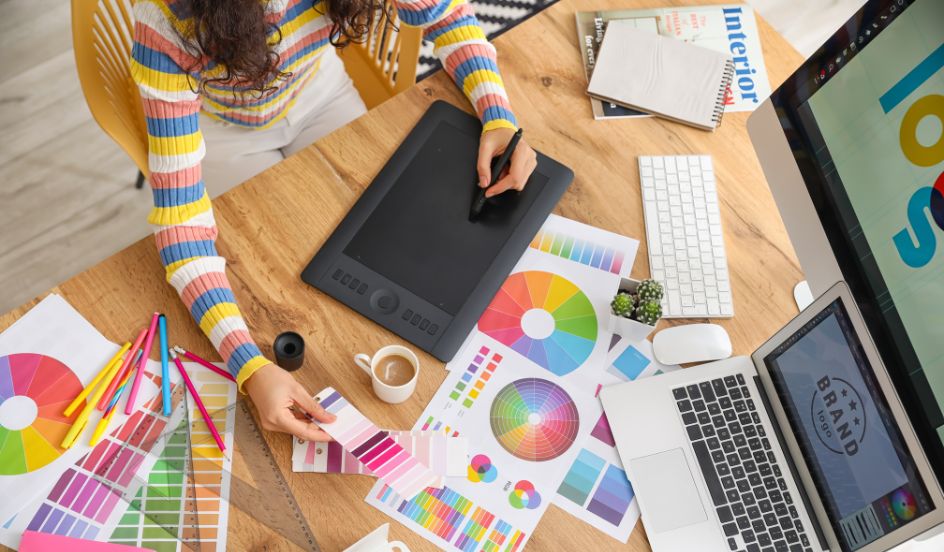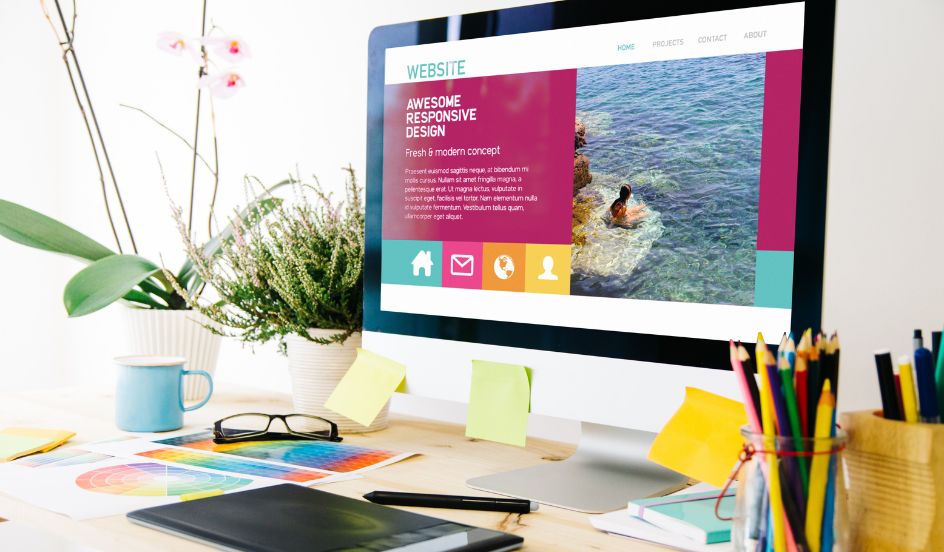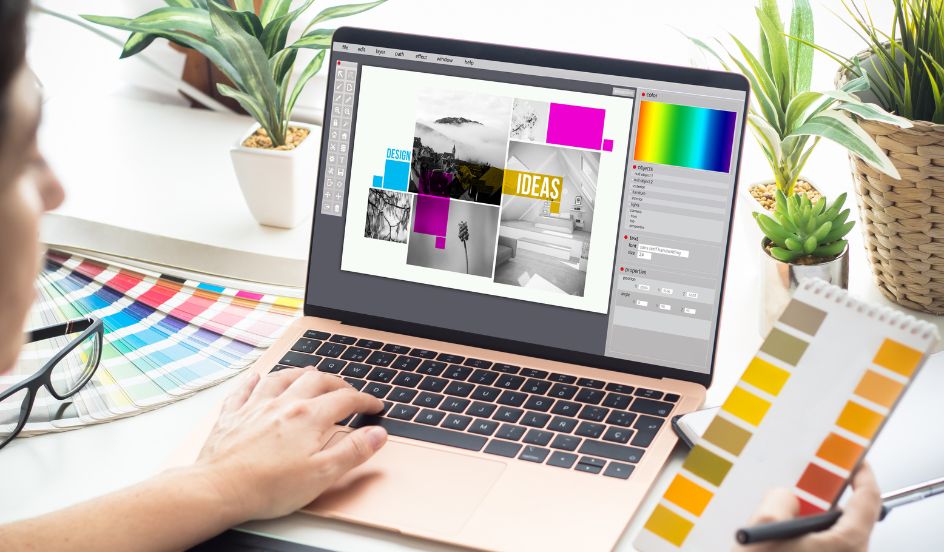What is a Graphic Designer?
January 2nd, 2024 / By Rebecca Dykeman
From the earliest cave paintings to television and films, humans have always possessed an appreciation for visual art and media. Throughout our history, we have used shape, colour, space, form, line, value, and texture to capture and convey our ideas, stories, and emotions through the mesmerizing power of imagery. It’s a legacy that has paved the way for the modern-day realm of graphic design — a field where creativity, aesthetics, and innovation come together to produce engaging visuals that shape the way we perceive and interact with information.
Think about the last time you saw a unique or striking advertisement or product package that caught your eye and made you want to look closer. Chances are, a graphic designer played a pivotal role in creating that visual experience. In this exciting article, we will explore graphic design in detail, including what it is, what graphic designers do, how to become a graphic designer, and the potential earnings in this creative profession.
 Graphic designers use colour theory to select harmonious colour palettes that evoke different emotions.
Graphic designers use colour theory to select harmonious colour palettes that evoke different emotions.What is Graphic Design?
Graphic design is the art and practice of creating captivating visual content that communicates messages, ideas, and information to a target audience. This is done using visual elements, such as typography, images, colours, and layout to create visually appealing and effective communication.
Graphic design is not confined to a single medium and can be applied to various platforms, including print materials such as posters, brochures, digital media, web design, advertising, branding, packaging, and more. It plays a fundamental role in shaping how we interpret and engage with information visually.
Michelle King-Tracey, a Graphic Design instructor at triOS College and veteran of the design industry can attest to this. “I have seen first-hand how graphic design can define brands and shape narratives. It offers the opportunity to leave a lasting impression in addition to being a vibrant career path,” she said.
“Having worked in the design and marketing industry for over 30 years, I have seen first-hand how graphic design can define brands and shape narratives. It offers the opportunity to leave a lasting impression in addition to being a vibrant career path. Our mission at triOS College goes beyond teaching the basics; we prepare tomorrow’s visionary designers.” – Michelle King-Tracey, Graphic Design Instructor at triOS College
There are many elements a graphic designer must take into account when crafting a successful design, such as understanding the intended audience, keeping brand imagery consistent, meeting project deadlines, understanding how colour affects emotions, ensuring visual hierarchy for an effective flow of information, and adapting designs to suit different mediums and screen sizes. When creating any kind of visual media, it’s important that designers understand the basic elements that go into creating effective design. Here are some examples of those elements:
Line: Lines are used to define shapes, create divisions, convey movement, and guide the viewer’s eye. They can be straight, curved, thick, thin, or any other variation. They play a crucial role in defining the structure and visual flow of a design.
Shape: Shapes are two-dimensional figures created by connecting lines or enclosing space. They can be geometric (circles, squares, etc.) or organic (naturally occurring shapes), and they are essential for creating structure and visual interest in a design.
Form: Form refers to three-dimensional objects that have depth, volume, and substance. In graphic design, creating the illusion of form is achieved through the use of shading, highlights, and perspective to add depth and dimension to two-dimensional designs.
Texture: Texture adds a tactile quality to a design, even though it is just a flat image on a screen or paper. It can be visual or implied and is used to convey the sensation of touch or feel. Texture can create depth and interest in a design.
Space: Space in graphic design refers to the area within and around the design elements. Effective use of space (both positive and negative) is crucial for achieving visual balance and maintaining clarity and readability.
Imagery: Imagery encompasses the use of visuals, including photographs, illustrations, and icons to convey messages and evoke emotions. In graphic design, imagery often serves as a powerful means of storytelling and engagement.
Typography: Typography is the selection and arrangement of typefaces, fonts, text sizes, line spacing, and text placement. It plays a significant role in conveying messages and establishing the visual tone of a design.
Colour: Colour is a potent tool in graphic design. Different colours can evoke specific emotions and communicate various messages. Designers use colour theory to select cohesive colour palettes that align with the design’s emotional themes.
Alignment: Alignment is the arrangement of elements along a common axis or edge. It creates structure and order in a design, making it visually pleasing and easy to navigate. Proper alignment ensures consistency and coherence.
Visual Hierarchy: Visual hierarchy is the arrangement of design elements to guide the viewer’s attention. It establishes an order of importance and helps viewers understand the content’s structure and significance. Elements such as contrast, size, and positioning can create visual hierarchy.
Balance: Balance involves the distribution of visual elements to create stability and harmony within a design. Designers use symmetrical or asymmetrical balance to control how elements are weighted within the composition.
Symmetry: Symmetry is a specific type of balance achieved when elements are evenly distributed around a central axis. It imparts a sense of formality and equilibrium, making it a useful choice in specific design contexts.
 Good graphic design can differentiate a pleasant and memorable user experience from a frustrating one.
Good graphic design can differentiate a pleasant and memorable user experience from a frustrating one.What Do Graphic Designers Do?
Graphic designers creatively solve problems and work on a wide range of projects that challenge their skills and imagination. They use their artistic creativity to help clients create visually stunning content that communicates their message effectively. A graphic designer might do some of the following:
Visual Identity and Branding: Graphic designers create logos, brand guidelines, and design elements to establish a cohesive and memorable brand identity. They transform their clients’ vision into captivating and visually appealing designs that reflect their brand values and goals.
Print Design: Graphic designers work on designing brochures, posters, magazines, and other printed materials. They create visually stunning designs that capture the audience’s attention and communicate their messages effectively.
Web Design: Graphic designers work on website design, user interface, and digital content. They create visually appealing designs that cater to users and represent the client’s brand.
Advertising: They develop visuals and layouts for advertising campaigns in various media including billboards, social media, and television. They create designs that are visually striking and grab consumers’ attention.
Illustration: Some graphic designers specialize in creating pictures for books, magazines, or digital platforms. They use different digital tools and platforms to create captivating illustrations.
Packaging Design: Designers work on the visual aspects of product packaging, ensuring that it attracts and informs consumers. They use their creativity to develop visually appealing designs that communicate the product’s features and benefits.
Typography: Choosing and manipulating fonts is a crucial aspect of graphic design as it greatly influences the readability and impact of a message. Graphic designers learn how to create visually stunning typography that is consistent with the emotion and intent that the final design is trying to convey.
Photography and Image Editing: Designers may be responsible for selecting or editing images to enhance the overall design. They use editing software to manipulate or produce visually appealing images that complement the design and communicate their messages effectively.
 A graphic designer may be in charge of advertising, branding, communication, and the overall visual appeal of products and services.
A graphic designer may be in charge of advertising, branding, communication, and the overall visual appeal of products and services.How to Become a Graphic Designer
Pursue Education: While a formal education isn’t always required, many graphic designers obtain some form of secondary education in graphic design or a related field. You can earn an associate or bachelor’s degree or a diploma in graphic design or take online courses and workshops to develop your skills.
Build a Portfolio: Your portfolio is your most significant asset as a graphic designer. It showcases your best work and is essential for landing clients or a job. Include a variety of projects that demonstrate your skills and versatility.
Master Design Software: Proficiency in design software such as Adobe Creative Cloud (includes Photoshop, Illustrator, and InDesign) is crucial. Learning these tools will make you more competitive in the job market. Graphic designers should be familiar with digital tools and technologies used in the industry.
Stay Updated: The field of graphic design is ever-evolving. Keep up with the latest design trends, technologies, and software updates to remain relevant. Graphic designers should be up-to-date with the industry’s latest advancements and should be willing to learn new skills.
Network: Building a professional network can open up opportunities. Attend design events and conferences, and join online communities to connect with fellow designers and potential clients. Graphic designers should be proactive in building professional networks and establishing connections within the industry.
 To remain competitive and relevant in the field, graphic designers must keep up with the latest design trends, software tools, and industry developments.
To remain competitive and relevant in the field, graphic designers must keep up with the latest design trends, software tools, and industry developments.How Much Do Graphic Designers Make?
The salary of a graphic designer in Canada can vary depending on factors such as location, experience, and specialization. According to Job Bank, graphic designers in Canada can expect to earn around $58,240 per year. However, experienced designers or those in high-demand areas may earn even more.
Additionally, it’s worth noting that the demand for graphic designers is expected to grow in Canada in the coming years, which could potentially drive up salaries. As more companies turn to digital marketing and branding, skilled graphic designers will be in greater demand. Furthermore, designers with expertise in areas such as web design, user experience, or animation may also have higher earning potential. It’s important to consider these factors when evaluating potential salaries in the field of graphic design.
With the right education and skills, you can unlock a world of opportunities in graphic design, where you can work on exciting projects and collaborate with clients from diverse industries. So, if you are looking for a fulfilling career that combines artistry with communication, check out triOS College’s Graphic Design diploma program to start traversing your road to success.
